How Easy to Get Ticket on Bullet Train With Rail Pass
A suggested 7-day itinerary in pictures...
There are so many places to visit in Japan. This is just a suggested itinerary for a first-timer, using a 7-day Japan Rail Pass to cover Tokyo, Kyoto with its temples and Gion geisha district, Hiroshima with its museum & Peace Park which everyone should see, Himeji with Japan's best-preserved traditional castle and Nagasaki, the city in Kyushu which for several hundred years was the only point of contact between Japan and the outside world. By visiting Hiroshima on the way out to Nagasaki and Himeji & Kyoto on the way back, it breaks up the journey nicely in each direction.
On this page...
![]() Japan by train: A 7-day itinerary in pictures
Japan by train: A 7-day itinerary in pictures
![]() Tokyo
Tokyo
![]() Hiroshima
Hiroshima
![]() Nagasaki
Nagasaki
![]() Kyoto
Kyoto
![]() Himeji
Himeji
![]() Nara & Nikko
Nara & Nikko
![]() How to arrange this itinerary yourself
How to arrange this itinerary yourself
Practical information on other pages...
![]() Useful country information
Useful country information
![]() How to check Japanese train times & fares
How to check Japanese train times & fares
![]() How a Japan Rail Pass works
How a Japan Rail Pass works
![]() Where to buy a Japan Rail Pass
Where to buy a Japan Rail Pass
![]() What are Japanese trains like?
What are Japanese trains like?
![]() Luggage, food & Japanese train travel tips
Luggage, food & Japanese train travel tips
Tokyo... See map of Tokyo
The obvious place to start is Tokyo, and most people spend a few days there at the beginning and end of their trip. You can get your railpass voucher exchanged for the actual pass while you're here, at any time in the 7 days before you want it to start. We stayed a night at the Tokyo Station Hotel, inside the historic 1915 station building itself, although it's not cheap. At the other end of the price scale, why not stay in a capsule hotel, at least if you are male and over 10.
 |
| Tokyo station, opened in 1915. The old station building on the Marunouchi side houses the 5-star Tokyo Station Hotel. |
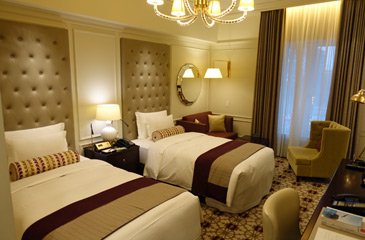 | 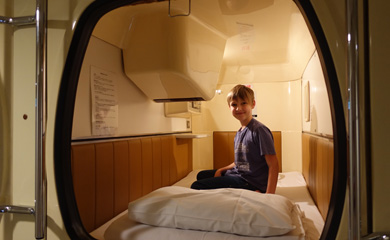 | |
| From one extreme to the other... Above left, the luxurious, historic and expensive Tokyo Station Hotel. And above right, the incredibly cheap Capsulevalue Kanda, one stop north of Tokyo station. | ||
Tokyo to Hiroshima by bullet train in 4h53... Watch the video
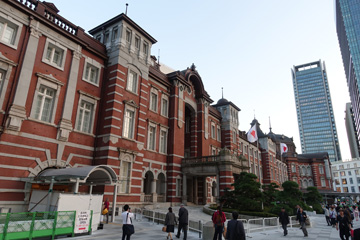 | 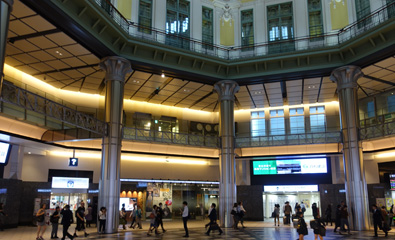 | |
| Tokyo station is a rabbit warren, lacking a main concourse and departure board as you'd find at most large stations. But it's well signed, in English as well as Japanese... | ||
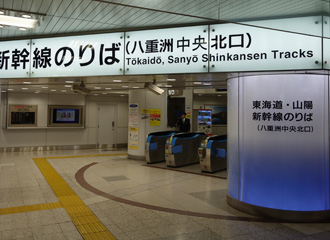 | 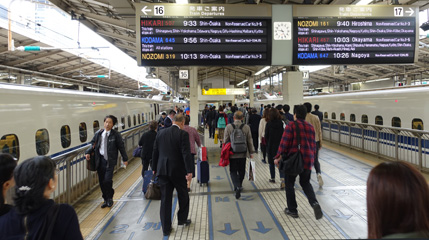 | |
| Find the entrance to the Tokaido Shinkansen platforms & go through the ticket gates - or rather, the staffed side gate, showing your rail pass... | The departure boards switch from Japanese to English & back, so it's easy to find your platform & train. Platform markings make it easy to stand where your car number will stop. All very organised! |
 |
| An N700A bullet train whisks us from Tokyo to Shin Osaka at up to 186mph - these trains are more properly referred to as shinkansen which simply means new trunk line. There are direct trains from Tokyo to Hiroshima, but almost all are classified as Nozomi which Japan Rail Pass holders can't use. So we take a semi-fast Hikari for Osaka where a connecting semi-fast Sakura connects for Hiroshima. |
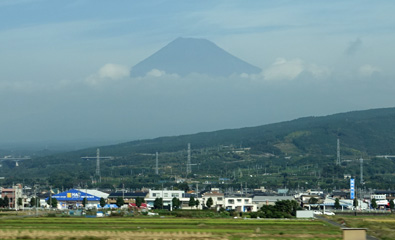 | 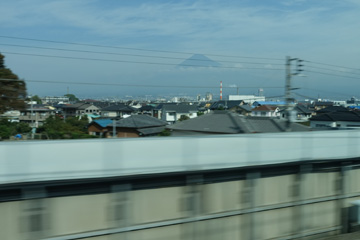 | |
| No, it really doesn't look like the mist-free bright-and-sunny snow-capped PR photos does it? And what lens makes the shinkansen look much closer than it is? But you can still sense its vast bulk as its summit emerges from the cloud... | ||
 |
| ...but you might be luckier than me. Photo courtesy of Peter Owens. |
 |
| Much of the coastal strip is built up. but there are pockets of countryside with rice fields in places... |
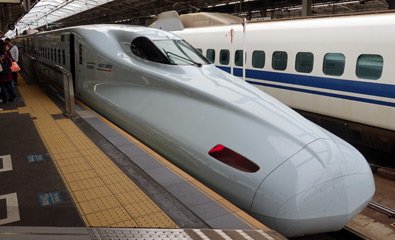 | 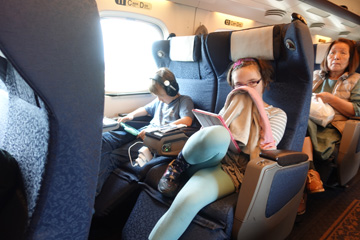 | |
| A quick and easy change at Shin Osaka onto a West Japan Railway N700 Sakura service to Hiroshima... | ||
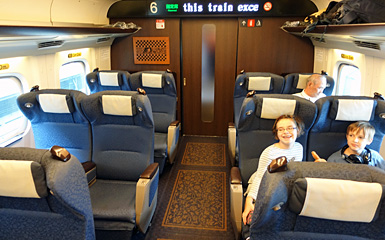 | 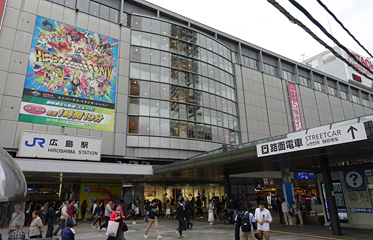 | |
| Arrival at Hiroshima station and taxi to our ryokan... | ||
Hiroshima... See map of Hiroshima
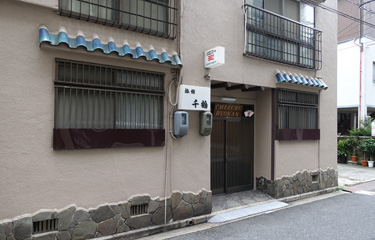 | 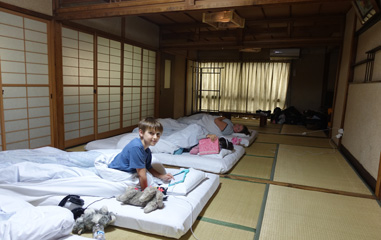 | |
| Not just a place to stay, but a chance to experience Japanese-style living... A family room at the excellent value Chizuru Ryokan in Hiroshima, just 10 minutes walk from Hiroshima's Peace Park. | ||
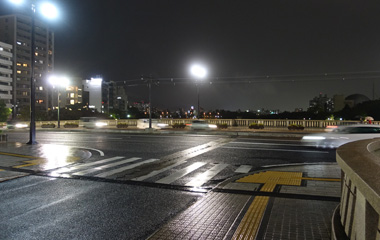 | 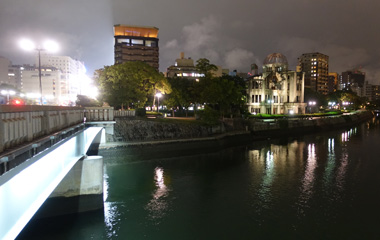 | |
| Wife and kids were tired in the evening so I wandered out on my own, heading for the Peace Park. The light of the streetlamps glistened on the wet roads. The ryokan was closer to the Peace Park than I'd thought and I miscalculated - I ended up on a bridge further to the north. But the bridge had a connecting span to the tip of the Park, making a T-shape. As I realised this, a shiver ran down my spine. I now knew where I was. This was the T-shaped Aioi Bridge, the distinctive feature used as the aiming point for the bombardier of the Enola Gay... | ||
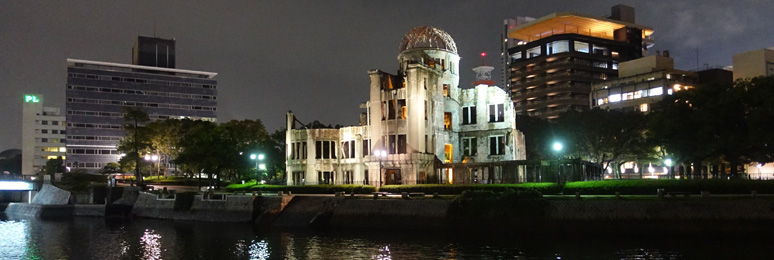 |
| I was almost the only person in the Peace Park late on a rainy night. Across the river, the former Industrial Promotions Hall built in 1915 and now known as the Peace Memorial or Peace Dome. |
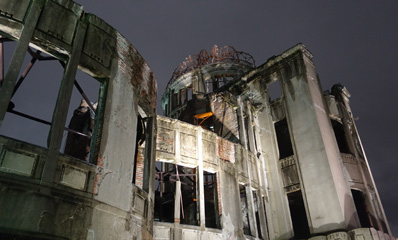 | 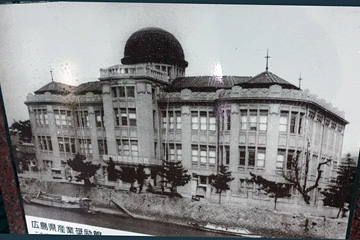 | |
| This old picture of the Industrial Promotions Hall as it once was (above right) is on a stone marker in the Peace Park, right where you stand for the best view of the building across the river... | ||
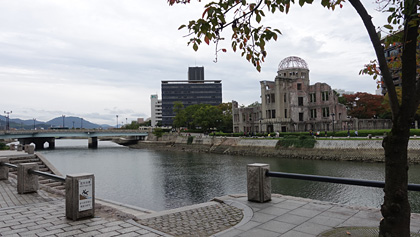 | 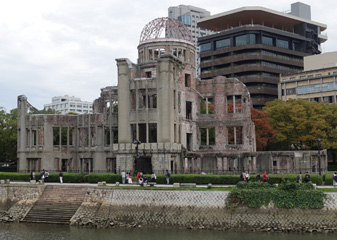 | |
| The UNESCO-listed Peace Dome by day. That's the Aioi Bridge in the left-hand photo. | ||
 |
| Hiroshima's Peace Park, seen from the first floor of the Atomic Bomb Museum... |
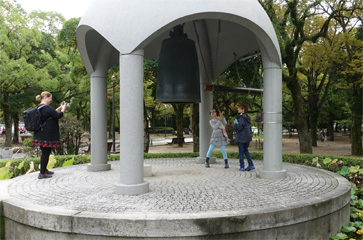 | 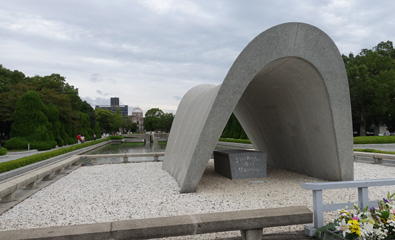 | |
| Giving the Peace Bell a good hard ring... | The cenotaph... |
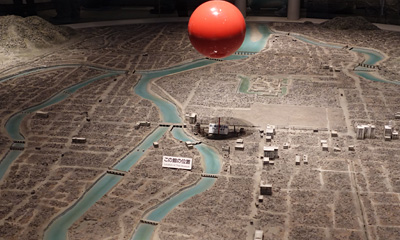 | 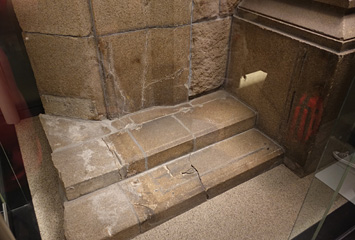 | |
| Museum model showing how the city was affected. The red ball is the airburst 1 second after detonation... | In the museum: A shadow is all that's left of a man sitting on bank steps waiting for the bank to open... |
Hiroshima to Nagasaki by shinkansen & limited express in 3h27... Watch the video
 |
| A West Japan Railway series N700 speeds us from Hiroshima to Shin Tosu on a semi-fast Sakura service... |
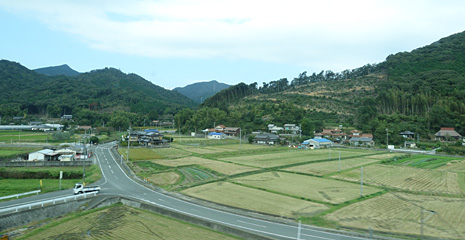 | 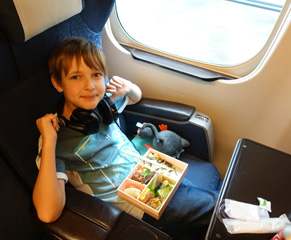 | |
| Away from the built-up areas there are a series of tunnels interspersed by green valleys... | ||
 |
| We take the shinkansen as far as Shin Tosu... |
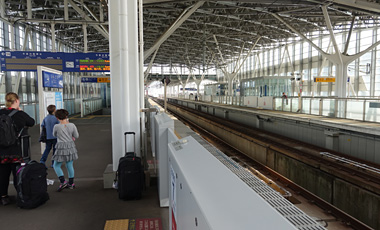 | 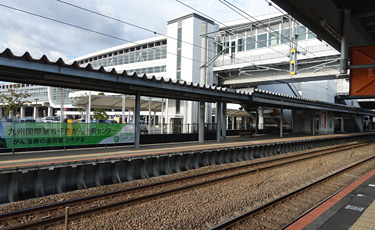 | |
| At Shin Tosu it's an easy change from the upper level standard gauge shinkansen platforms (above left) down to the two lower level narrow gauge platforms (above right). | ||
 |
| We take the Limited Express Kamome (meaning seagull) from Shin Tosu to Nagasaki... |
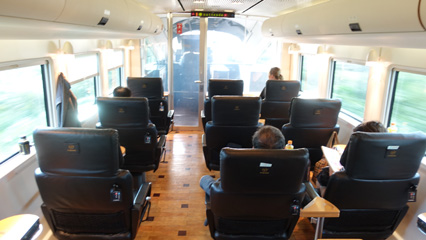 | 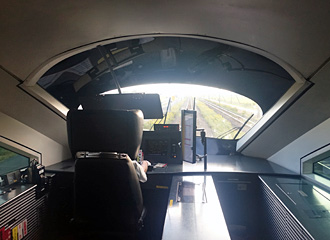 | |
| Our green car seats are right at the front with a view past the driver. Black leather seats & varnished parquet floors, one swish train. | ||
 |
| Across Kyushu by train, past rice field and villages.... |
 |
| ...and along the coast. |
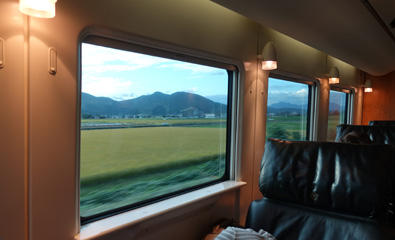 | 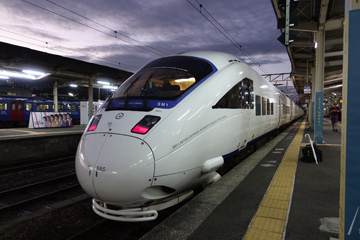 | |
| The end of the line, the bullet-nosed Kamome Limited Express reaches Nagasaki... | ||
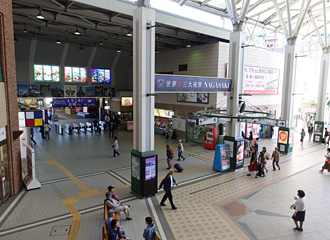 | 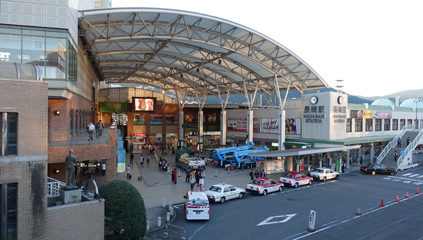 | |
| Nagasaki station. There are plenty of hotels in Nagasaki, we used the businesslike JR Kyushu Hotel, a railway-owned hotel right at the station... | ||
Nagasaki... See map of Nagasaki
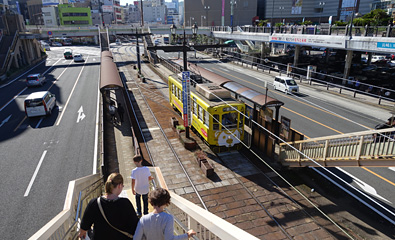 | 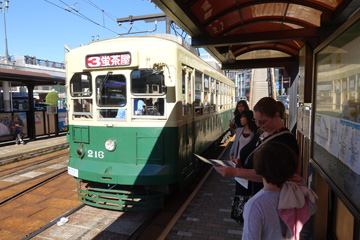 | |
| Take the tram! The best way to get around Nagasaki's sights is by tram, with a cheap one-day pass bought from the tourist information kiosk on the station concourse. A large footbridge links the railway station to the tram platforms. There's tram information & a tram route map at http://visit-nagasaki.com. | ||
 |
| Dejima... Dejima is an artificial island built in 1634 on what was then Nagasaki harbour front. It's now a little way from the harbour as the city has expanded onto reclaimed land. Originally built for the Portuguese, Dejima was used by the Dutch from 1641 to 1853, and was the sole point of contact between Japan & the outside world in the Edo period - the only place where foreigners were allowed. Several 19th century buidling survive, the 17th & 18th century buidlings have been reconstructed just as they were, including the Opperhoofd's (Chief Factor's) house with interior set up as it was in the 19th century. Dejima is a Nagasaki must see. For more information see https://en.wikipedia.org/wiki/Dejima. |
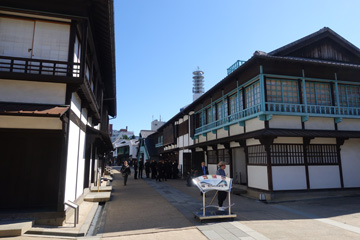 | 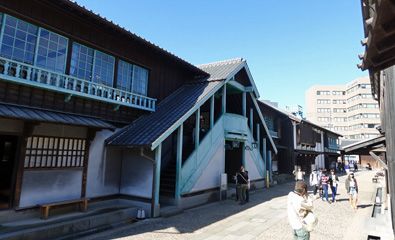 | |
| Main street in Dejima... | The Opperhoofd (Chief factor's) house... |
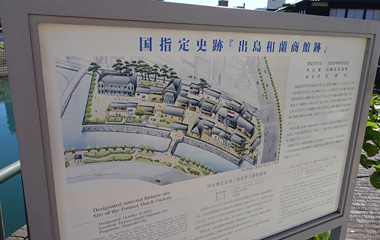 | 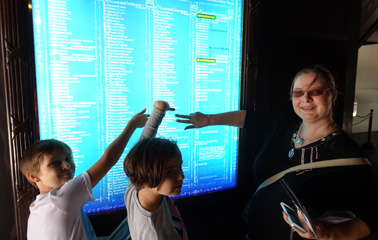 | |
| Isaac Titsing... My Dutch mother-in-law's maiden name is Titsing and she has an 18th century ancestor called Isaac Titzing who we knew worked in Japan in a fairly senior capacity. Incredibly, we find he was Opperhoofd at Dejima - the head honcho - and his name appears in the official list as Opperhoofd in 1780 & 1782-84. https://en.wikipedia.org/wiki/Isaac_Titsingh. | ||
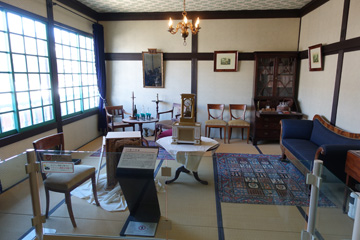 | 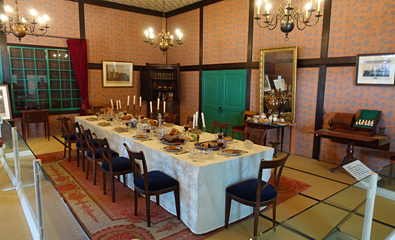 | |
| Interior of the reconstructed Opperhoofd's house at Dejima, as it would have looked in the 18th century... | ||
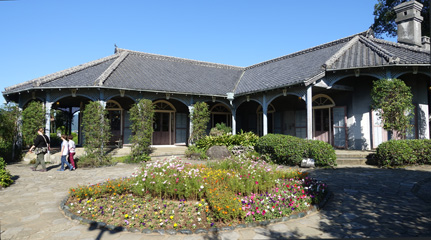 | 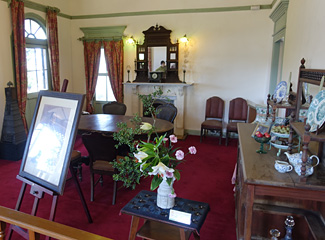 | |
| Glover Garden... Another tram ride & a short walk up the hill brings us to the Glover Garden. Various colonial villas from the 19th & 20th centuries have been moved and rebuilt here, surrounded by a garden. See www.glover-garden.jp. | ||
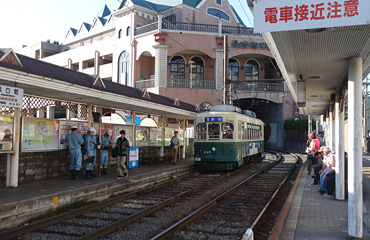 | 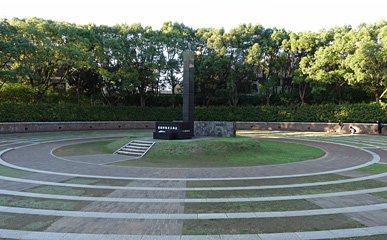 | |
| Nagasaki atomic bomb... The frequent number 1 tram takes you from Nagasaki railway station to Matsuyama-Machi tram stop, a 15 minute ride. From here it's a few minute's walk to the atomic bomb hypocentre, marked by an obelisk, pictured above right. The bomb burst some 500m above ground level at 11:02 on 9 August 1945 in the suburb of Urakami, which is a little way north of central Nagasaki. It has mountains on either side which contained the blast, and although the damage spread as far south as Nagasaki railway station, this is why Dejima, Oura Church and the villas now in the Glover Garden survived. Nagasaki was only ever a secondary target - the primary target, Kokura, had been obscured by cloud. | ||
 |
| Nagasaki Peace Statue. It seems to be a favourite place to have school photos taken... The Atomic Bomb Museum is nearby, it should not be missed, see http://nagasakipeace.jp. |
Nagasaki to Kyoto by limited express & shinkansen in 5h30...
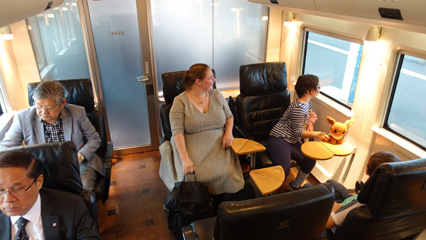 | 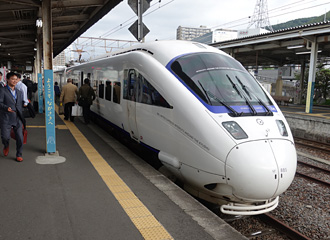 | |
| Limited Express Kamome from Nagasaki to Shin Tosu, then N700 shinkansen to Shin Osaka and Limited Express Thunderbird to Kyoto. | ||
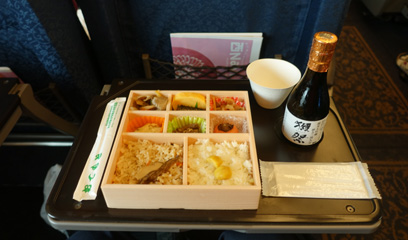 | 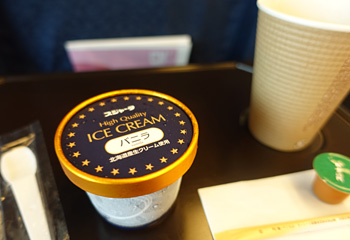 | |
| Lunch on the move... On the shinkansen from Shin Tosu to Osaka it's ekiben & sake for lunch, rounded off with strawberry ice cream - all bought from the on-board trolley, which accepts cards. | ||
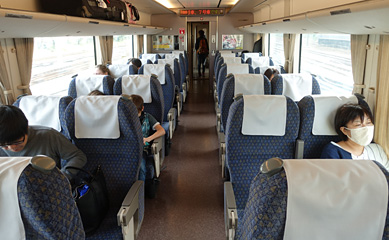 | 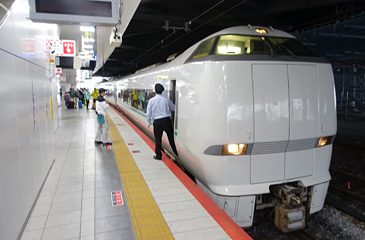 | |
| Thunderbirds are go... Last lap, a short hop from Shin Osaka to Kyoto on the Limited Express Thunderbird. In many ways, nicer than the shinkansen with spacious seating and large picture windows... | ||
Kyoto... See map of Kyoto
Kyoto was the capital of Japan from 794AD until 1867, and should be on every first-timer's itinerary...
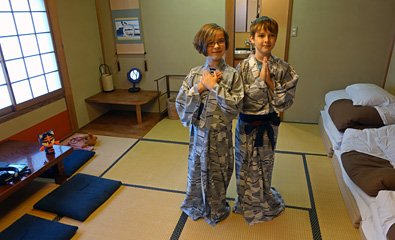 | 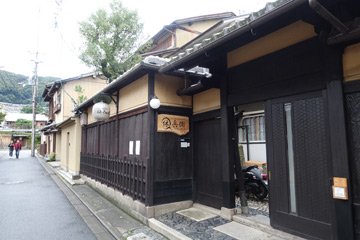 | |
| Another chance to stay in a Japanese-style ryokan. The Gion Ryokan Q-Beh is just 10-15 minutes walk from the Kiyomizu-dera temple and 10 minutes walk from the Gion Geisha district. It has budget dorm rooms and private rooms, and free WiFi. Above left, a family room with shower & toilet which comes complete with kimono - or more accurately yukata. | ||
 |
| The famous Kinkaku-ji temple or Golden Pavilion is on the edge of town, a 45 minute bus ride from the centre. It looks idyllic - and is - but just out of shot vast crowds file steadily past it... |
 |
| Gion's geisha district at night. If you're very lucky you might spot a geisha hurrying to and from an appointment. But most of the 'geishas' you see in Gion are tourists who've rented a geisha outfit from a local rental shop. The selfie-sticks and less-than-perfectly-poised walk are a dead give-away. |
Kyoto to Himeji by limited express Super Hakuto in 1h25...
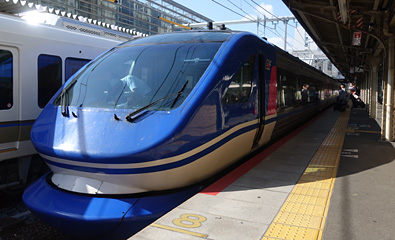 | 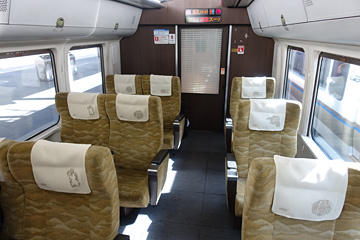 | |
| Kyoto to Himeji by Limited Express Super Hakuto, in green car... | ||
 |
| This part of Japan is largely built-up, although between Kyoto & Himeji the train skirts the sea... |
Himeji... See map of Himeji
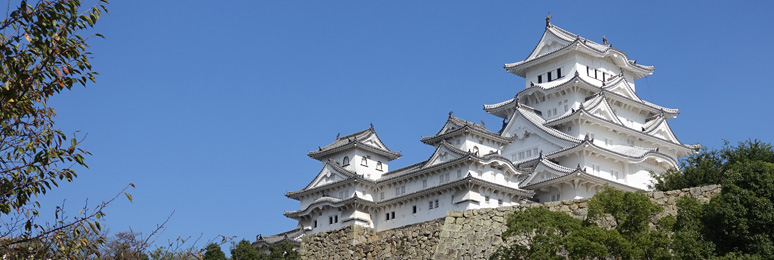 |
| Himeji is home to the best-preserved traditional castle in Japan, located right in the centre of the city. You walk out of the station and the castle is at the far end of the main street which stretches out in front of you, a 15 minute walk. See https://en.wikipedia.org/wiki/Himeji_Castle. |
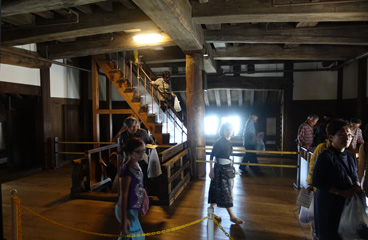 | 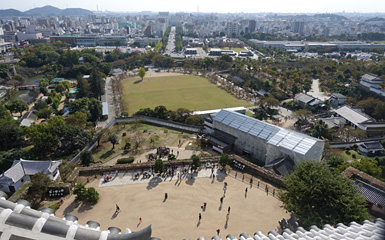 | |
| Inside Himeji castle... | View from the top with the station in the far distance. |
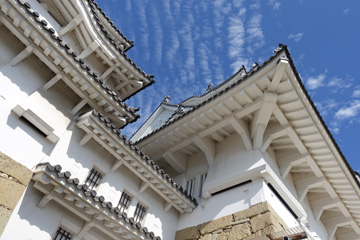 | 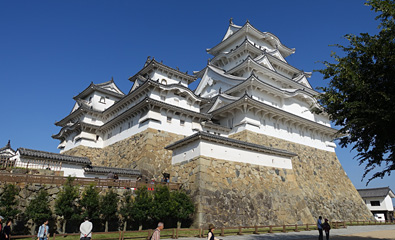 | |
| Himeji castle in all its glory... | ||
Himeji to Tokyo by sleeper train Sunrise Express...
We could easily have returned to Tokyo by shinkansen in just 3h50. But there aren't many sleeper trains left in Japan and we wanted to try one....
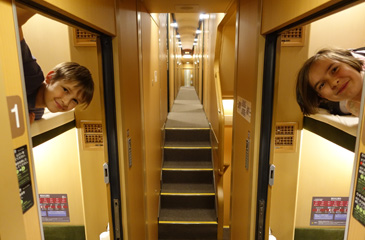 | 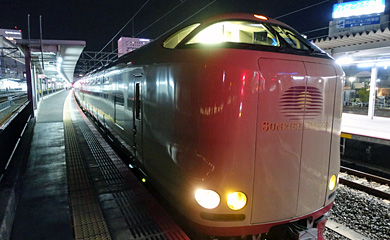 | |
| ...so we splurged on two comfy twin-bed sleepers from Himeji to Tokyo on the Sunrise Express, or rather from Okayama to Tokyo as we doubled back using our passes to board the sleeper at Okayama at 22:30 rather than at Himeji at 23:30. It's not cheap - roughly �185 per twin room - but great fun, bunk beds on a train! | ||
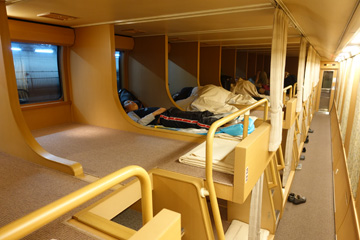 | 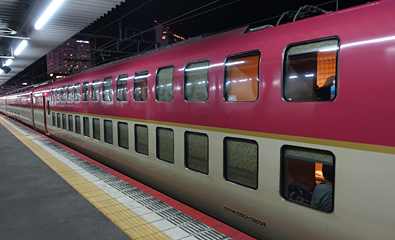 | |
| But it's possible for passholders to travel on the Sunrise Express for free: Japan Rail Pass holders can use these nobinobi carpet berths free of charge, you just need to make a reservation. | ||
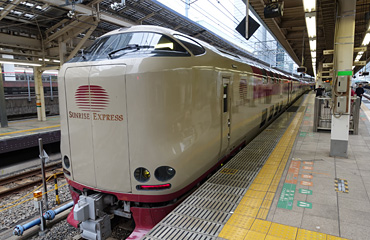 | 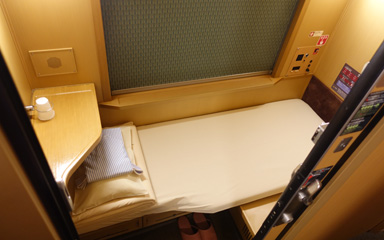 | |
| Finally, we're back where it all started, Tokyo station... | ||
If you've more time: Nara & Nikko...
Nikko... See map of Nikko
Nikko makes a great day trip from Tokyo. Nikko's history as a sacred site began in the middle of the 8th century AD. There are many temples and historic buildings spread through woodland in the hills around this small town, including the famous three monkeys, See no evil, hear no evil, speak no evil.
Frequent trains run by the Tobu Railway (www.tobu.co.jp) link Tokyo Asakusa station with Tobu-Nikko station in as little as 1h50 - their Limited Express Spacia trains are very comfortable indeed. However, Japan Rail Passes don't cover the Tobu Railway so you'll need to buy a ticket.
If you want to use a Japan Rail Pass you can do so by taking a shinkansen from Tokyo main station to Utsunomiya and changing for the local train to Nikko JR station, total journey time also around 1h50. Check times at www.hyperdia.com.
Nara... See map of Nara
A worthwhile day trip from Kyoto, Nara is home to the Great Hall of the Buddha (Todai-ji), the world's largest wooden building, housing the world's largest bronze Buddha, see www.todaiji.or.jp. Two train services link Kyoto & Nara:
If you're buying regular tickets for this trip rather than using a pass, Kyoto to Nara takes just 35 minutes by Limited Express or 45 minutes by rapid train on the Kyoto-Kintetsu Railway (www.kintetsu.co.jp), with at two or three trains an hour to Nara Kintetsu station located close to all the sights. This is the best route to use.
However, the Kyoto-Kintetsu Railway isn't covered by a Japan Rail Pass, if you want to use a pass you can take the JR Nara Line which takes 44 minutes, running every half hour but to JR Nara station which is a slightly longer walk from the attractions, check JR train times at www.hyperdia.com.
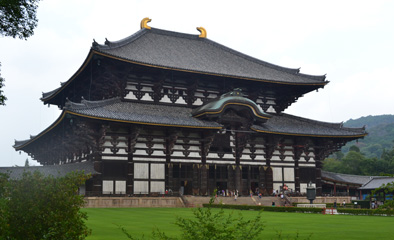 | 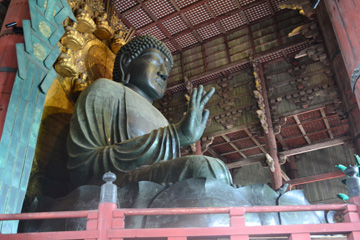 | |
| The Great Hall of the Buddha, Nara. Photos courtesy of David Smith. | ||
Watch the video: Tokyo to Hiroshima by shinkansen...
Watch the video: Hiroshima to Nagasaki by shinkansen & limited express...
How to book this itinerary...
-
Option 1, arrange it yourself, which is the budget option. Just sort your flights to and from Japan, arrange hotels or ryokans through Booking.com and buy a Japan Rail Pass at www.jrailpass.com, they'll deliver passes worldwide. For info on Japan Rail pass and booking Japanese trains, see the Train Travel in Japan page.
-
Option 2, let train travel specialist Railbookers arrange it all for you, with trains, hotels, transfer (and if you want, flights) all sorted as a package, hassle free. I have arranged for Railbookers to offer this exact suggested itinerary as I think it's ideal for a first trip to Japan, their Reflections of Japan version is a 10-day tour which includes Nara & Nikko as well, but they can customise it to shorten or lengthen it to fit your requirements. Railbookers is an ABTA member and holidays including flights are ATOL protected.
 UK call 0207 864 4600, www.railbookers.co.uk.
UK call 0207 864 4600, www.railbookers.co.uk. US call free 1-888-829-4775, www.railbookers.com.
US call free 1-888-829-4775, www.railbookers.com. Canada call free 1-855-882-2910, www.railbookers.com.
Canada call free 1-855-882-2910, www.railbookers.com. Australia call toll-free 1300 971 526, www.railbookers.com.au.
Australia call toll-free 1300 971 526, www.railbookers.com.au. New Zealand call toll-free 0800 000 554 or see website.
New Zealand call toll-free 0800 000 554 or see website.

Back to home page
Source: https://www.seat61.com/bullet-train-across-japan.htm
0 Response to "How Easy to Get Ticket on Bullet Train With Rail Pass"
Post a Comment